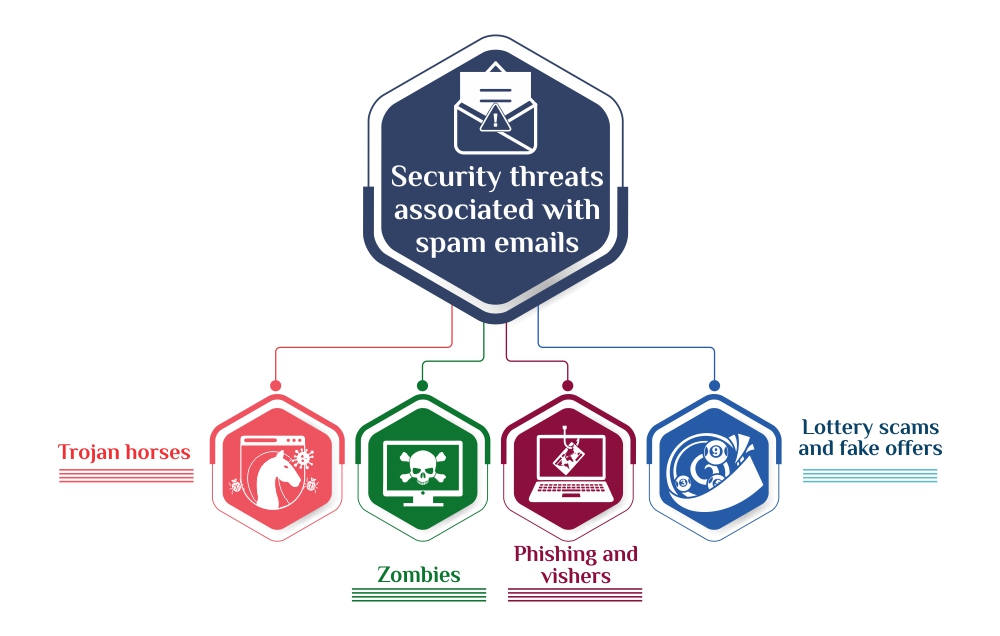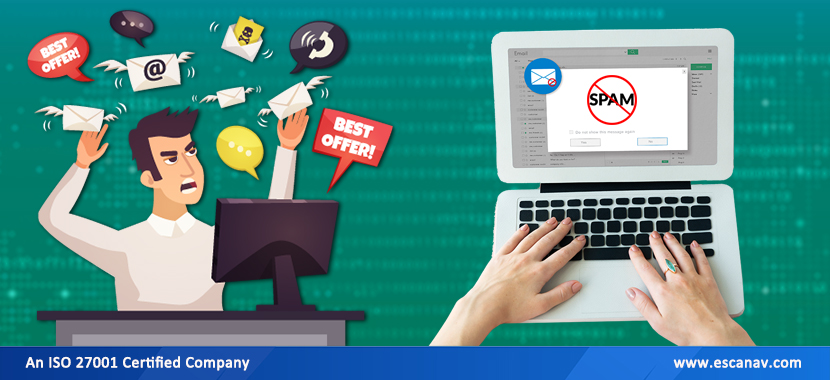In email terms, spam is an uninvited, bulk-sent message delivered to your inbox. You probably receive both spam and marketing messages on a regular basis, but there’s one significant difference between the two: permission.
You’ll receive legitimate marketing emails if you opt in to receive them. They allow you to sign up for newsletters, join social networks, browse members-only content, and read members-only messages.
Spam messages often contain explicit or illegal content and are sent from illegitimate email addresses. A bulk email sent by an anonymous sender often uses scare tactics, contains typos, and includes misleading information. The unsubscribe link is rarely present in these emails, and if it is, the link may contain malware. Having malware installed on your computer, smartphone, and other devices could lead to cybercriminals gaining access.
Emails that are unwanted can be slowed down in a few different ways. These five simple steps will eliminate spam emails from your inbox.
1. Declare spam
There are algorithms built into many email services, such as Gmail, Yahoo Mail, Microsoft Outlook, and Apple Mail, that automatically filter out spam.
However, if you find a spam message in your inbox, don’t delete it; mark it as spam. In the spam folder, suspicious emails will be placed after they are marked as spam. Whenever you receive an email from this address, the spam filter will know not to allow it into your inbox.
Using a trained email filter, you can identify blacklisted addresses and phrases such as “cheap,” “Viagra,” or “free.”
2. Remove all phishing emails.
Whenever you receive spam emails, there is a golden rule: if it looks like spam, it probably is. Delete it without clicking or downloading anything. In some cases, such emails contain software that confirms you have opened the message, which may lead to more spam.
Your email address can be stolen by malware programs and used to resend spam messages under the guise of an actual address. It is possible for impostors to pose as someone you know, like a close relative, friend, or colleague. Consider contacting the sender outside of your email account if the message appears to come from someone you know.
You’ll receive spam messages in a spam folder when you block them. As flagged messages accumulate, this folder grows. This means that you’ll have to empty it occasionally.
Here are five key factors to look for in a suspicious email, even if they are not fool-proof.
Inquiring about
personal information
usually, the sender will request your name, address, and
Social Security number,
or banking information.
Unreliable email
address
Usually, the domain name of the email is suspicious, or the
address uses uncommon characters.
Senders
who really are unknown or unfamiliar
A fake email claiming to be an influencer, a high-ranking
official, or a legitimate company. It is possible that these companies will
claim you have made purchases when you have not.
Messages requiring immediate action
The title box or subject line of these emails contain action words such as “Immediate,” “Limited Time,” and “Urgent.”The email contains errors.
Typos and errors in fake emails, like spelling your name incorrectly or using bad grammar, are common.
3. Ensure the privacy of your email address
The number of spam emails you receive can increase if you give out your email address. Therefore, if it’s not absolutely necessary to share, keep it private.
When posting on social media or leaving online comments, don’t include your e-mail address. For social media purposes, it might be helpful to create a separate email address that will only be used for social media, ensuring your other email address remains private.
4. Ensure that your spam is being blocked by a third-party spam filter
In addition to your email service provider’s spam filter, you can also use a third-party spam filter to increase cybersecurity. Two spam filters will filter the emails before they reach your inbox. If it gets past one spam filter, it should be caught by the other.
Your devices can be protected against malware threats, attacks, and undesirable content with the aid of effective spam filters. Make sure your anti-spam filter works with your email provider and meets your own requirements.
5. Your email address needs to be changed
Your email address might have been exposed in a data breach if spam keeps coming in. When cybercriminals have your information, it can be hard to prevent spam. It is possible to change your email address in this case.
When you use free email services like Gmail, you can set up multiple accounts so that you can limit the amount of spam you receive. This is how you do it:
- The first step is to register with your current email service for a new account.
- Once you’ve changed your email address, notify your contacts from your new account.
- The final step is to navigate to the Settings section and add the new email address to forward your old account’s incoming emails to.
How to Configure a Forwarding Address
If you create a new address, you might want to set it up so that you still receive emails from your old one after setting it up. This can be accomplished by adjusting the forwarding settings.
When you forward your email address, all accounts associated with your original account can be updated with your updated contact information. Here are four easy steps to follow:
1. Navigate to the Settings option in the old email account.
2. Navigate to the Forwarding and POP/IMAP tab.
3. Enter the new email address in the Add a forwarding address box.
4. Click “Next” to confirm the procedure.
Ensure that both accounts are kept open for a few months so that any remaining messages can be forwarded.
6. Unsubscribe from email subscription lists
Maintaining a low profile is possible by unsubscribing from mailing lists. The marketing industry often gathers your email address through online forms, social media, and scraping tools, and also purchases it from other companies. As a result, the fewer newsletters you subscribe to, the less likely it is that marketers and spammers will be able to find your address. Here are two ways to unsubscribe from individual and bulk emails:
The following are two methods for unsubscribing from individual and bulk emails:
You can unsubscribe from marketing emails by clicking the unsubscribe button at the bottom of the email. There is also an unsubscribe button next to the From: and To fields in some email clients, such as Gmail:
How to Unsubscribe data From Multiple Emails
1. Type “Unsubscribe” into the inbox search bar.
2. Select the Create Filter option from the drop-down menu next to the box.
3. Check the boxes for Delete and Apply Filter to Matching Conversations.
4. Make the filter.
The selected emails will be moved to the trash as a result. The process of unsubscribing and eliminating multiple emails is as easy as clicking a few buttons.
Knowing the most common threats helps you identify and rid yourself of spam emails
Security threats associated with spam emails
The number of spam emails you receive is annoying enough, but some are harmful to your digital safety. Cyberthreats, viruses, and malware can be contained in spam messages. Here are some to be aware of.

Trojan horses
Trojan horses disguise themselves as legitimate programmes. Even if you believe you understand how to verify the legitimacy of an email, a trojan horse uses deception to circumvent those defence mechanisms.
For instance, they might appear as an email attachment from someone you know or be concealed within free software downloads.
When you open the email, the trojan wants to install malicious code — usually spyware or viruses — on your computer that is designed to cause problems.
It could enable an attacker to take control of your computer, lock you out, and steal your data, account information, or email addresses. Having installed anti-malware software may assist you in detecting these trojans. Avoid clicking on pop-up messages on your computer to avoid trojan horses. If you’re getting a lot of pop-ups, you should run an antivirus scan.
Zombies
Zombies are a type of malware that is spread through email attachments. They turn your computer into a server, from which they send spam to other computers. You may be unaware that your computer is infected, but it may experience significant slowdown or battery drain. In the meantime, your computer may be sending spam or attacking websites.
Avoiding opening attachments or clicking links in emails from your spam folder is one method to stay away from zombies.
Phishing and vishers
Phishing emails frequently attempt to imitate messages from legitimate financial institutions or other businesses you may use. The spam phishing email will direct you to a fraudulent or spoof website to re-enter your credit card information or verify your password. It’s a ruse to obtain that personal information.
Vishers will attempt to contact you via phone in order to obtain your personal information. Remember that reputable companies would not make such requests via email or phone.
To avoid phishing scams, conduct a Google search on the company’s name.
For vishers, If you don’t recognise the number, allow the caller to leave a voice message. Only respond to calls in your phone book, whether they are local or not.
Lottery scams and fake offers
Cyber thieves will sometimes use old-school scams that appear legitimate but are fake offers. These take advantage of your desires or good nature: You’ve won a large sum of money or someone urgently requires your assistance.
In reality, you haven’t won a jackpot or a world cruise. And you haven’t been chosen by a foreign prince to receive $10 million in exchange for your bank account number.
To avoid lottery scams and fake offers, look for words like “Immediate” and “Act Now” in the email’s title. For more information, see the Delete Emails section of this post.
How to Avoid Spam
So far, there is no such thing as a spam “do not email” list. Until then, you’ll have to deal with spam on your own.
Fortunately, there are excellent tools available to assist you. Most email programmes include spam filters, which can aid in the detection and isolation of spam. Spam is often filtered out by internet service providers, so it never reaches your computer. However, it is prudent to install and run anti-virus security software that can remove viruses that may already be present on your computer. If spam manages to get past these filters, take the simplest approach to suspicious emails and click Delete.







